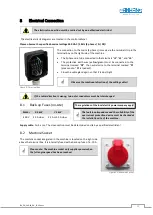
BA_PH_245-20_EN_15-22.docx
15
Electrical equipment must be maintained and cleaned regularly.
Pay attention to the danger of crushing on workpiece guides and moving machine parts.
Make sure that no unauthorised persons are in the area of the machine.
Be aware of the risk of injury from flying tool parts in the event of tool breakage.
Therefore wear protective goggles.
Be aware of the risk of injury from flying workpiece parts and chips, splinters and dust coming out
of the machine. Therefore wear protective goggles.
Be aware of the increased noise emission and wear hearing protection.
Be aware of the increased dust generation. Use the extraction device and wear a dust mask if
necessary.
The emergency stop buttons must always be freely accessible. They must not be moved, e.g. with
hopper boxes. Check the function of the emergency stop buttons daily (before starting work).
Fire hazard due to wood dust in connection with flying sparks and/or open fire!
4.2.4
Observe the Environmental Protection Regulations
During all work with the machine, the environmental protection regulations, obligations and laws for waste
avoidance and proper recycling and/or disposal applicable at the place of use must be observed. This applies in
particular to installation, repair and maintenance work involving substances that could pollute the groundwater
(e.g. hydraulic oils and cleaning agents and liquids containing solvents). In any case, prevent them from seeping
into the ground or entering the sewage system.
Store and transport the above-mentioned hazardous substances only in suitable con-
tainers. Avoid leakage of hazardous substances by using suitable collection contain-
ers. Ensure that the above-mentioned substances are disposed of by a qualified dis-
posal company.
4.2.5
Organisational Measures
Always keep this operating manual within easy reach and at the place of use of the machine.
In addition to the operating manual, observe and instruct on generally applicable legal and other binding
regulations for accident prevention and environmental protection.
Supplement the operating manual with further instructions, including supervisory and reporting duties, to
take account of special operational features (e.g. with regard to work organisation, work processes, per-
sonnel employed).
Before starting work on the machine, the person responsible for its operation must have read the operat-
ing instructions, especially the chapter "Safety Instructions". This applies in particular to personnel who
only occasionally work on the machine.
Check that work is carried out in a safety-conscious and hazard-conscious manner and in compliance with
the operating manual.
Operators must not wear open long hair, loose clothing or jewellery (including rings). There is a risk of in-
jury, e.g. by getting caught or drawn in.
Observe the safety instructions and danger warnings on the machine and keep them complete and in legi-
ble condition.
In case of safety-relevant changes to the machine or its operating behaviour, shut down the entire system
immediately and report the fault to the responsible office/person.
Use personal protective equipment as necessary or required by regulations.
Do not make any modifications, additional attachments or conversions to the machine without the manu-
facturer's approval! This will compromise safety and invalidate the manufacturer's warranty and any lia-
bility claim.
















































